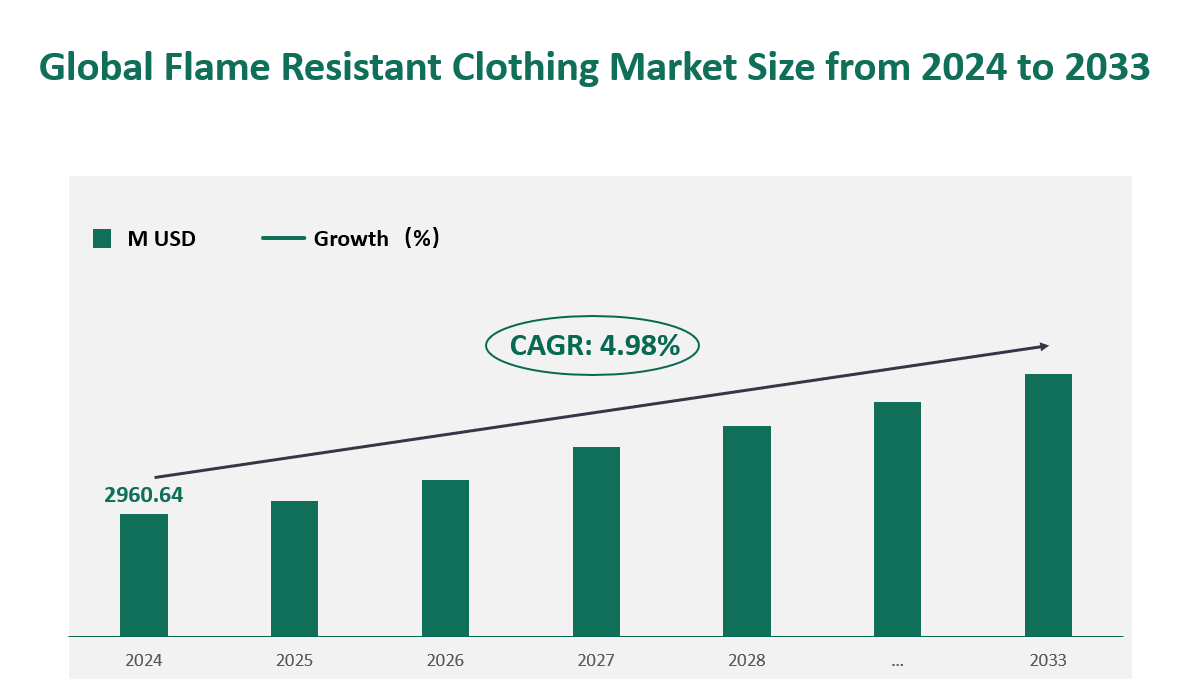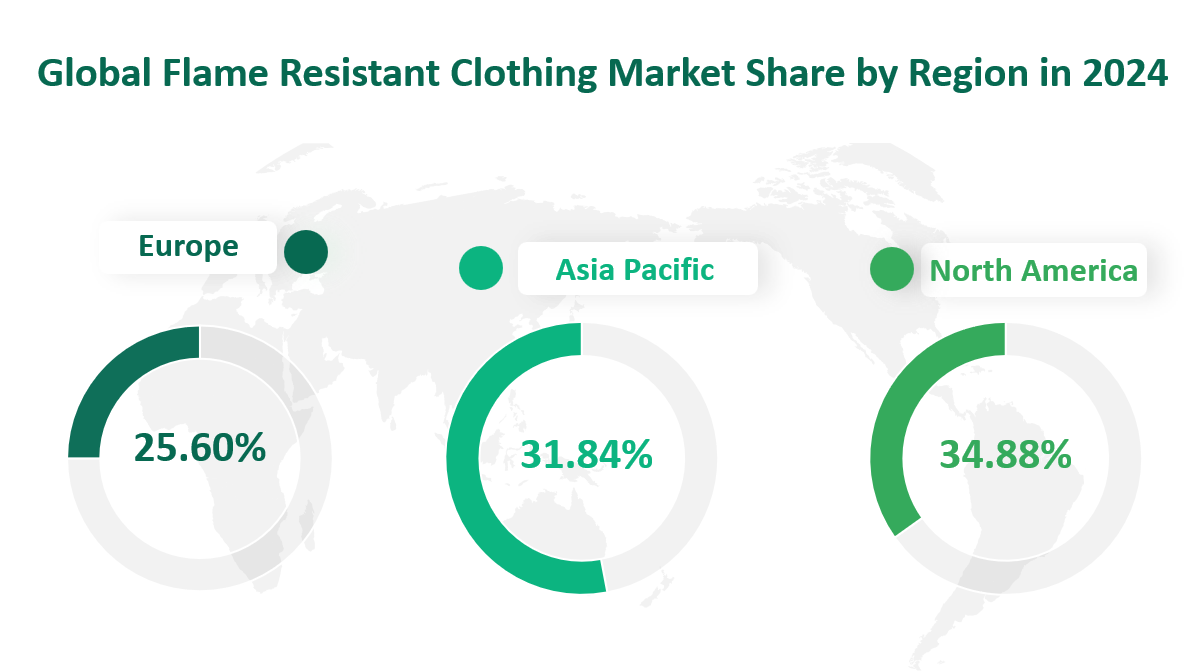1 Global Flame Resistant Clothing Market Size (Revenue) and CAGR (2024-2033)
Global Flame Resistant Clothing market generated revenue of USD 2960.64 Million in 2024 with a CAGR of 4.98% during 2024 to 2033.
The current situation of the Flame Resistant Clothing market is characterized by steady growth and increasing demand across various industries. In 2024, the global market value reached 2960.64 M USD, reflecting a healthy expansion from previous years. This growth is driven by several factors, including the increasing awareness of workplace safety, particularly in industries such as firefighting, military, chemical, petrochemical, and electrical sectors. The market is also influenced by the development of new materials and technologies that enhance the performance and comfort of flame-resistant clothing.
The market is highly competitive, with major players such as Bulwark Protection, Sioen, and Carhartt holding significant market shares. These companies are continuously investing in research and development to improve product quality and introduce new features that meet the evolving needs of consumers. Additionally, the market is seeing a trend towards more sustainable and environmentally friendly materials, as well as a focus on gender-specific designs to accommodate the growing number of women in traditionally male-dominated industries.
Figure Global Flame Resistant Clothing Market Size (M USD) Outlook (2024-2033)

2 Flame Resistant Clothing Market Trends
Table Market Trends of Fire Protection Clothing
Trends | Description |
Green flame resistant clothing is a permanent development trend | Manufacturers stress that quality and safety are more important than cost considerations. Newer, safer and more scientific will prevail. Green, environment-friendly, high-quality flame resistant clothing is the future development trend, for example, the melt spinning fiber of environmental protection, long-term flame retardant, melt drop resistance, smoke suppression integration, and the wet spinning fiber of high strength, environmental protection, long-term flame retardant. The balance of the workability, flame retardancy, melting drop resistance, smoke suppression and mechanical properties of flame retarding polymer is the research and development direction of flame resistant clothing in the future. |
Manufacturers Introduce Fire Protection Clothing to Suit Women’s Build | Gender diversity is becoming reality across various industries as women are foraying into industries such as oil & gas, chemical, and mining industry. Perpetually increasing percentage of woman employees in these industries has created new opportunities for flame resistant clothing industry. According to the United Nations Economic Commission for Europe (UNECE), female representation in top oil & gas companies is around 11%, and this number is likely to increase rapidly in the upcoming years, which is expected to result in its increasing growth over the forecast period. To gain a competitive edge in the market, flame resistant clothing manufacturers are focusing on enhancing functionality, without compromising on the aesthetics. |
3 Global Flame Resistant Clothing Market by Type in 2024
Flame Resistant Clothing (FRC) is designed to protect wearers from burns by withstanding heat or exposure to flame without combusting or breaking open. In 2024, the market for FRC was diverse, with various product types catering to different needs and industries. The main product types include shirts, pants, outerwear, coveralls, and others.
Shirts are essential for providing upper body protection. They are often made from inherently nonflammable fabrics and materials that are naturally resistant to flames. In 2024, shirts accounted for a significant portion of the FRC market, with a market share of 27.82%. The market size for shirts was 15885 K Units, reflecting their widespread use across industries such as firefighting, military, and electrical work.
Pants offer lower body protection and are crucial for workers in environments with potential fire hazards. Pants had a market share of 28.90% in 2024, with a market size of 16497 K Units. This indicates that pants were slightly more popular than shirts, possibly due to the nature of work in industries like petrochemical and chemical, where full-body protection is often required.
Outerwear includes jackets and coats that provide additional layers of protection. In 2024, outerwear had a market share of 20.22% and a market size of 11544 K Units. Outerwear is particularly important in cold weather conditions or in industries where workers need to layer their protective clothing.
Coveralls are one-piece garments that cover the entire body, offering comprehensive protection. They had a market share of 16.90% in 2024, with a market size of 9648 K Units. Coveralls are essential in industries such as chemical and petrochemical, where there is a high risk of exposure to hazardous materials and fire.
Among these product types, pants had the largest market share in 2024, indicating their widespread use and importance in providing lower body protection. In terms of growth rate, the market data shows that all product types are expected to grow steadily, but shirts and outerwear are projected to have slightly higher growth rates in the coming years, driven by increasing demand for lightweight and comfortable protective clothing.
Table Global Flame Resistant Clothing Market Size and Share by Type in 2024
Product Type | Market Size (K Units) | Market Share |
|---|---|---|
Shirts | 15885 | 27.82% |
Pants | 16497 | 28.90% |
Outerwear | 11544 | 20.22% |
Coveralls | 9648 | 16.90% |
Others | 3518 | 6.16% |
Total | 57093 | 100.00% |
4 Global Flame Resistant Clothing Market by Application in 2024
The applications of Flame Resistant Clothing are diverse, covering a range of industries where fire safety is a critical concern. In 2024, the market was segmented into several key applications, each with its own market size and share.
Fire-fighting is one of the most significant applications, as firefighters are constantly exposed to fire and heat. In 2024, the fire-fighting segment had a market share of 30.43% and a market size of 17373 K Units. This high market share reflects the essential role of FRC in protecting firefighters and ensuring their safety during emergency operations.
Military personnel also require FRC to protect against fire-related hazards in various operational scenarios. The military segment had a market share of 19.81% in 2024, with a market size of 11312 K Units. The use of FRC in the military is driven by the need to protect soldiers in combat and training situations where fire risks are present.
Chemical industries involve the handling of hazardous materials, making FRC essential for worker safety. The chemical segment had a market share of 8.21% in 2024, with a market size of 4688 K Units. The growth in this segment is driven by increasing regulations and safety standards in chemical plants.
Petrochemical industries are another major application area, given the high risk of fire and explosions. The petrochemical segment had a market share of 12.69% in 2024, with a market size of 7242 K Units. The demand for FRC in this sector is expected to grow due to the expansion of petrochemical facilities and the need for enhanced safety measures.
Electrical workers are at risk of electrical fires and arc flashes, making FRC a necessity. The electrical segment had a market share of 21.81% in 2024, with a market size of 12453 K Units. The growth in this segment is driven by the increasing complexity of electrical systems and the need for worker protection.
Among these applications, fire-fighting had the largest market share in 2024, highlighting the critical need for FRC in this sector. In terms of growth rate, the petrochemical and chemical segments are expected to grow at a faster pace in the coming years, driven by the expansion of these industries and increasing safety regulations.
Table Global Flame Resistant Clothing Market Size and Share by Application in 2024
Application | Market Size (K Units) | Market Share |
|---|---|---|
Fire-fighting | 17373 | 30.43% |
Military | 11312 | 19.81% |
Chemical | 4688 | 8.21% |
Petrochemical | 7242 | 12.69% |
Electrical | 12453 | 21.81% |
Others | 4025 | 7.05% |
Total | 57093 | 100.00% |
5 Global Flame Resistant Clothing Market by Region in 2024
In 2024, the global Flame Resistant Clothing (FRC) market exhibited a dynamic landscape across major regions, each contributing uniquely to the overall market size and growth trajectory. North America, Europe, Asia-Pacific, Latin America, and the Middle East and Africa were the key regions analyzed, with each region showcasing distinct market characteristics and potential.
North America emerged as the largest regional market by revenue, with a significant share of 34.88%. This region’s dominance can be attributed to its robust industrial base, stringent safety regulations, and a high level of awareness regarding workplace safety. The United States and Canada, in particular, were the primary drivers of this market, with the U.S. accounting for the majority of the sales and revenue. The market size in North America was 19914 K Units, reflecting a strong demand for FRC across various industries such as firefighting, military, and petrochemical.
Europe followed closely, holding a market share of 25.60% in 2024. The European market’s strength lies in its diverse industrial sectors and a well-established network of manufacturers and distributors. Countries like Germany, the UK, France, and Italy were significant contributors, with Germany leading in terms of market size and growth. The European market size was 14617 K Units, driven by the need for high-quality protective clothing in industries such as chemical and electrical.
Asia-Pacific was the fastest-growing region, with a market share of 31.84% in 2024. This region’s growth is fueled by rapid industrialization, increasing urbanization, and a growing emphasis on safety standards in emerging economies like China, Japan, South Korea, and India. The market size in Asia-Pacific was 18177 K Units, indicating a substantial expansion driven by the chemical and petrochemical sectors, which are experiencing significant growth in this region.
Latin America and the Middle East and Africa also contributed to the global market, with shares of 3.64% and 4.05% respectively. Latin America’s market size was 2076 K Units, while the Middle East and Africa’s market size was 2310 K Units. These regions are poised for growth due to increasing industrial activities and the adoption of advanced safety practices.
Table Global Flame Resistant Clothing Market Size, Region Wise in 2024
Region | Market Size (K Units) | Market Share |
|---|---|---|
North America | 19914 | 34.88% |
Europe | 14617 | 25.60% |
Asia-Pacific | 18177 | 31.84% |
Latin America | 2076 | 3.64% |
Middle East and Africa | 2310 | 4.05% |
Total | 57093 | 100.00% |
Figure Global Flame Resistant Clothing Market Share, Region Wise in 2024

6 Global Flame Resistant Clothing Market Top 3 Players
Bulwark Protection is a leading name in the FRC industry, known for its high-quality flame-resistant workwear. Established in 1971, the company has a strong market distribution worldwide, with manufacturing plants primarily located in the United States. Bulwark Protection offers a wide range of products, including shirts, pants, outerwear, and coveralls, designed to meet the stringent safety requirements of industries such as firefighting and petrochemical. In 2022, Bulwark Protection reported a revenue of 230.63 M USD, reflecting its dominant position in the market.
Sioen is a European market leader in professional protective clothing, with a strong presence in over 80 countries. Founded in 1960, Sioen is part of the Sioen Industries group, which also includes divisions specializing in coated technical textiles and fine chemicals. Sioen’s product portfolio includes flame-retardant and anti-static T-shirts, among other protective garments. The company’s revenue in 2022 was 165.08 M USD, highlighting its significant contribution to the European and global markets.
Carhartt is a well-known brand in the workwear industry, offering a comprehensive range of products designed for durability and protection. Established in 1889, Carhartt has a global market distribution, with manufacturing facilities in the United States. The company’s product line includes outerwear, shirts, pants, and accessories, all designed to meet the demands of workers in various industries. Carhartt’s revenue in 2022 was 123.39 M USD, showcasing its strong market position and brand recognition.
Table Global Flame Resistant Clothing Revenue of Top3 Players in 2022
Company | Revenue (M USD) |
Bulwark Protection | 230.63 |
Sioen | 165.08 |
Carhartt | 123.39 |

